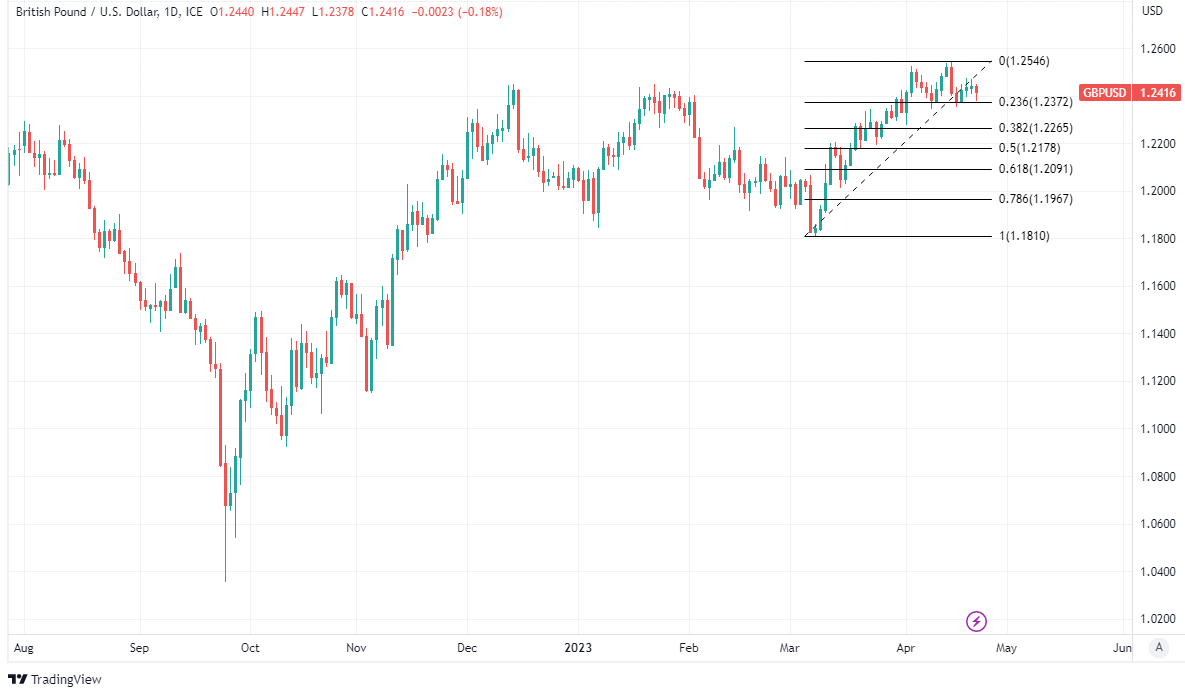GBP/USD Tipped for 1.26 to 1.27 Area in Q2 at BMO Capital Markets
- Written by: James Skinner
-
"You probably don't want to be buying sterling if core inflation remains stubborn above 5% after three more 25bps rate hikes from the BoE, which is currently priced into OIS," BMO Capital Markets.

Image © Adobe Images
The Pound to Dollar exchange rate pared earlier gains in the final session of the week but could reach one-year highs near 1.27 this quarter if the interest rate differential narrows in support of Sterling but there are also risks to that forecast, according to BMO Capital Markets.
Dollars were bought widely in North American trade on Friday when Sterling was an underperformer as financial markets contemplated poor retail sales figures from the UK and Canada, as well as the latest S&P Global PMI surveys of manufacturing and services sectors in Europe and the U.S.
Pound to Dollar losses came after S&P Global said April likely marked the first instance of growth in the U.S. manufacturing sector since September and that a quickening expansion in the services sector contributed to output prices rising at their fastest pace in a number of months.
This is a downside influence on the UK-US interest rate differential and has uncertain implications for Pound to Dollar outlook, although BMO Capital Markets forecasts suggest risks are on the upside for both and that Sterling is likely to rise to something like 1.26 or 1.27 over the second quarter.
"The Fed will pause soon, other central banks will catch up to the Fed, and interest rate differentials will compress. I expect this dynamic to weigh on USD vs major European currencies at the 1M-3M portion of the curve," says Stephen Gallo, a global FX strategist at BMO Capital Markets, in an earlier note.
 Above: Pound to Dollar rate shown at 2-hour intervals.
Above: Pound to Dollar rate shown at 2-hour intervals.
"Further out, if UK inflation metrics do not fall on a relative basis, the picture for sterling becomes more problematic," he adds.
Gallo and the BMO team have flagged UK inflation as a risk beyond that horizon after Office for National Statistics data revealed on Wednesday that price pressures were slower to dissipate in March than many economists had expected.
Consensus had been for inflation to fall into the single digits for last month but it actually declined from 10.4% to 10.1%, while remaining unchanged at 6.2% when volatile prices of energy and food are removed from the basket.
"You probably don't want to be buying sterling if core inflation remains stubborn above 5% after three more 25bps rate hikes from the BoE, which is currently priced into OIS," BMO's Gallo warns.
GBP/USD Forecasts Q2 2023Period: Q2 2023 Onwards |
"If the Q2 data reveal a meaningful drop in price pressures, there is probably a stronger case for GBP to avoid an isolated decline. My base case is the second scenario, but I am more worried about the first," he adds.
Wednesday's inflation data was consistent with the idea that the UK is more susceptible to inflation than other advanced economies, one that has been widely articulated by economists in recent years.
And the risk of an elongated return to the 2% target was clear in Tuesday's employment data, which confirmed a consistently high level of wage growth.
Friday's UK PMI echoed these figures with a more modest rise in output prices for the month April while also warning of a continuing elevation of inflation due to rising wage settlements, and all of this is where the upside risk to the GBP/USD interest rate differential comes in.
 Above: GBP/USD at daily intervals with Fibonacci retracements of March rally indicating possible areas of technical support. Click for closer inspection.
Above: GBP/USD at daily intervals with Fibonacci retracements of March rally indicating possible areas of technical support. Click for closer inspection.
All of the above has resulted in markets assigning a high probability to the prospect of the Bank of England (BoE) Bank Rate being lifted further, which has been supportive of the interest rate differential, though Gallo has warned that appetite for Sterling could deteriorate quickly in some circumstances.
"There was a time when FX investors would sell the currency of a country where inflation was consistently higher than that of its main trading partners," Gallo says.
"We haven't seen this dynamic in the FX market recently because the inflation dilemma has occurred synchronously across G10. However, the environment could revert to the historical norm as developments turn more idiosyncratic," he adds in a Wednesday research briefing.
This would be especially likely if inflation does not fall meaningfully up ahead including on a relative basis where it's measured against other countries,
The BoE's forecasts will be updated in May but its most recent projections suggested inflation would fall rapidly this quarter before ending the year near 4%, and eventually declining quite some distance below the two percent target.





